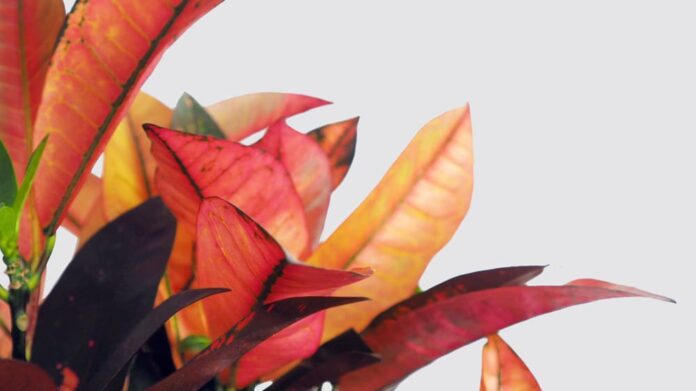Croton plants, with their bright, multicoloured leaves, are a fantastic addition to any home. They bring a splash of colour and can make any space feel lively. However, caring for a croton plant can be tricky if you are unfamiliar with its needs.
This article will walk you through everything you need to know to keep your Croton plant healthy and how to do Croton plant care:
What is a Croton Plant?
Croton plants, known scientifically as Codiaeum variegatum, are tropical plants native to Southeast Asia. They are famous for their bold and vibrant leaves, which can be a mix of red, yellow, green, orange, and even black. Each leaf can have several colours, making these plants truly eye-catching.
| Aspect | Details |
|---|---|
| Appearance | Colourful, tropical leaves in various shapes and sizes. |
| Ideal for | Adding a tropical touch to any room, brightens up indoor spaces. |
| Care Level | Relatively easy to care for once basic needs are understood. |
| Basic Needs | Requires bright, indirect light, well-draining soil, and moderate watering. |
Why Choose a Croton Plant?
Croton plants are perfect for adding a touch of the tropics to your home. Their colourful leaves can brighten up any room, and they come in various shapes and sizes to fit different spaces. Additionally, crotons are relatively easy to take Croton plant care of once you understand their basic needs.
Light Requirements
Croton plants love bright light. They need much sunlight to maintain their vibrant colours. Place your croton near a window with at least six to eight hours of bright, indirect sunlight each day. If your plant does not get enough light, its leaves might lose their colour and become dull.
Tips for Providing Adequate Light
- Place your croton near a south-facing window if possible.
- If you notice the leaves losing their colour, move the plant to a brighter spot.
- During winter months, consider using a grow light to supplement natural sunlight.
Water your Croton
Croton plants require regular watering. They prefer consistently moist soil but can be sensitive to overwatering. The key is to keep the soil evenly moist without letting it get soggy. Water your croton when the top inch of soil feels dry.
How to water in a correct way
- Use lukewarm water to avoid shocking the roots of the plant.
- Water thoroughly until water drains out of the bottom of the pot.
- Avoid letting the plant sit in water to prevent root rot.
Humidity needs
Croton plants thrive in high humidity. They are tropical plants, so they love a humid environment. If the air in your home is too dry, especially in the winter, you might notice the edges of the leaves turning brown.
Increasing humidity
- Mist your Croton regularly with water.
- Place a humidity tray under the plant.
- Use a humidifier in the room where your croton is located.
Temperature preferences
Croton plants prefer warm temperatures between 60°F and 85°F (15°C and 29°C). They do not like sudden temperature changes or drafts, so keep them away from open windows, doors, and air conditioners.
Fertilizing Croton Plants
Regular fertilisation is important to keep your Croton plant healthy and colourful. Use a balanced, water-soluble fertiliser every month during the growing season (spring and summer).
How to Fertilize
- Dilute the fertiliser according to the instructions on the package.
- Apply the fertiliser to moist soil to avoid burning the roots.
- Reduce the frequency of fertilisation during the fall and winter months.
Pruning Croton plants
Pruning helps keep your croton plant looking neat and encourages new growth. Remove any dead or damaged leaves as soon as you notice them.
Steps for Pruning
- Use clean, sharp scissors or pruning shears.
- Cut back leggy stems to encourage bushier growth.
- Remove any leaves that are discoloured or unhealthy.
Repotting Your croton
As your croton plant grows, it will eventually need to be repotted. This usually happens every two to three years. Repotting gives the plant more room to grow and refreshes the soil.
Some Questions You Should Know
What kind of soil is best for croton plants?
Croton plants thrive in well-draining soil. A good potting mix for crotons includes equal parts of peat, pine bark, and perlite or coarse sand. This mix ensures that water drains well and the roots have enough air circulation.
How often should I fertilise my croton plant?
During the growing season (spring and summer), fertilise your croton plant monthly with a balanced, water-soluble fertilizer. In the fall and winter, reduce the frequency to once every two months as the plant’s growth slows.
Can I propagate my Croton plant?
Yes, croton plants can be propagated through stem cuttings. Take a cutting from a healthy plant, remove the lower leaves, and place it in water or moist soil. Keep the cutting in a warm, bright spot until roots develop.
Why are the leaves of my croton plant turning brown?
Brown leaves can indicate several issues. They might be due to low humidity, underwatering, or too much direct sunlight. Check the plant’s environment and adjust to provide more humidity, consistent watering, and indirect light.
How do I know if my croton plant is getting too much water?
Overwatering can cause the leaves of your Croton plant to turn yellow and the roots to rot. You might water too much if the soil is constantly wet and soggy. Allow the top inch of soil to dry out before watering again.
Can croton plants tolerate low light?
While croton plants prefer bright, indirect light, they can tolerate lower light conditions. However, their colors may not be as vibrant, and growth may slow. If the plant’s colours are fading, try moving it to a brighter spot.
Is it normal for my croton plant to lose leaves?
It is normal for croton plants to lose some leaves, especially when adjusting to a new environment. However, excessive leaf drop can be a sign of stress. Ensure the plant is getting consistent light, water, and humidity.
Conclusion
Croton plants are not just beautiful but also easy to take a proper Croton plant care for once you understand their needs. Their vibrant, multicoloured leaves can add a tropical flair to any home. You can enjoy a healthy and thriving croton plant by giving the right amount of light, water, humidity, and nutrients. Regular maintenance, such as pruning and repotting, will also help keep your plant in top shape.
Read More:















